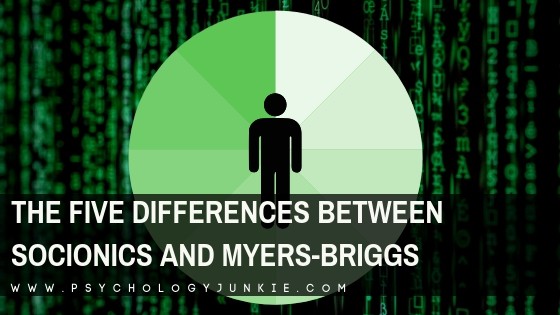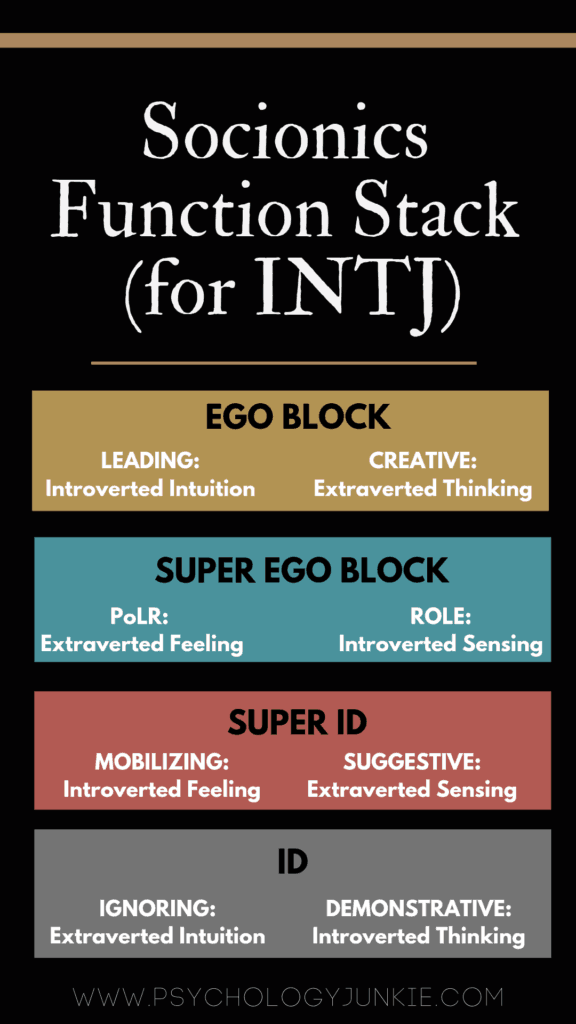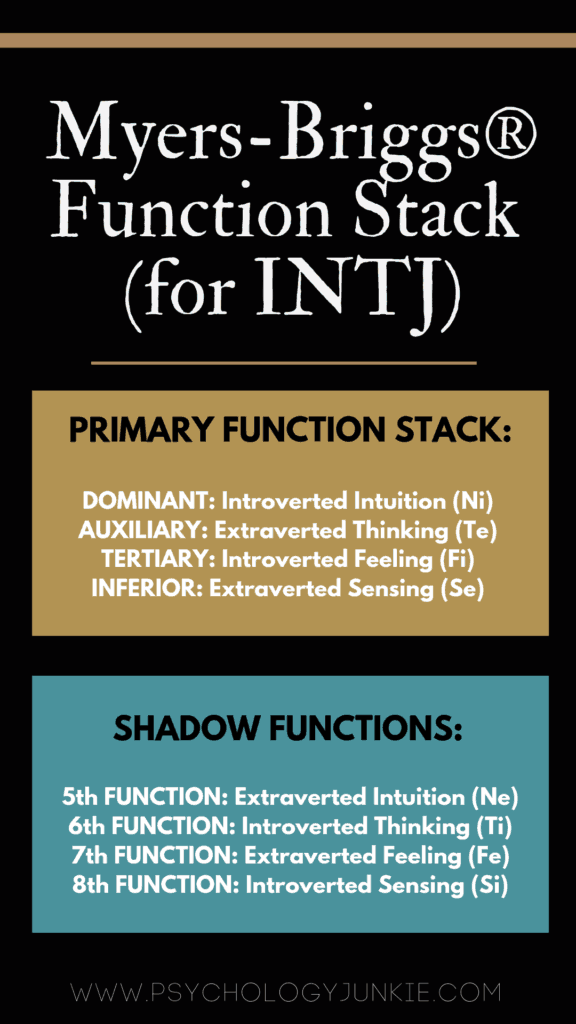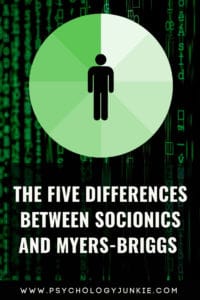The Five Differences Between Socionics and Myers-Briggs
This article is a guest post written by Johannes Karlsson, founder of Sociothena.com
Have you ever heard the name “socionics” pop up in a conversation about MBTI, as a comparison or complement? Have you heard about quadras, the demonstrative function, or the aristocratic types, but don’t have a clue what these things mean? Fear not – here is a minor introduction to the younger but (I think) smarter sister of MBTI®, and a comparison of the five major differences between these two theories.

Socionics was developed in the 1970s and 80s by a Lithuanian sociologist and economist called Aushra Augusta. Its purpose was to map out relationships and how personality types interact with each other. The theory is based not only on Carl Jung’s work on cognitive functions, but also a theory called information metabolism. The basic premise of socionics is the same as that of the MBTI; the interaction between Carl Jung’s cognitive functions, both in the “function stack” and in relationship to other people. There are, however, certain aspects that makes socionics different from Myers-Briggs, and that’s what I want to discuss here.
The Five Differences Between Socionics and Myers-Briggs
A Note Before We Begin:
This article might be confusing if you’re brand new to learning about personality type. If you’ve just learned your type and are trying to understand more about the basics (like what I/E, S/N, T/F, and J/P mean) this might be a little confusing for you. You can find out more about the basics of socionics here and more about the basics of Myers-Briggs here. However, if you’ve been learning about type for a while, you’ll probably find this article easy to understand and enlightening!
The First Difference: Socionics Ego-Blocks Versus Myers-Briggs Function “Stack”
One of the most apparent differences when we take just a quick glance at Myers-Briggs and socionics side-by-side, is the function stack. According to Myers-Briggs typology, each of us has a “primary” stack of four functions. For example, an INFJ would have the following function stack:
INFJ Function Stack:
Dominant Function: Introverted Intuition (Ni)
Auxiliary Function: Extraverted Feeling (Fe)
Tertiary Function: Introverted Thinking (Ti)
Inferior Function: Extraverted Sensing (Se)
Myers-Briggs experts disagree on how the remaining four functions (in the case of the INFJ: Ne, Fi, Te, and Si) affect individuals. John Beebe created an 8-function model for each type, but MBTI® practitioners are divided on its reliability.
Socionics describes how we use all eight functions in detail. Socionics divides these functions into four different blocks. You can get a look at the difference between the two function stacks in the graphics below:

One thing that is unique in socionics is that the functions work together in “blocks” rather than as a “stack”. The functions don’t stand by themselves, but are paired together. For example, the leading and creative functions (dominant and auxiliary in MBTI®) are in the same block: the “ego”. There are four such blocks; the ego, the super-ego, the id, and the super-id. Each block contains two functions, and we have different attitudes and approaches to each block. For a simple look at them, we can divide them into strong (ego and id) and weak (super-ego and super-id) blocks, as well as valued (ego and super-id) and subdued (id and super-ego) blocks.
Two of the blocks in the socionics “stack” are strong (ego and id); we can easily deal with the functions in these blocks. The other two blocks, the super-ego and super-id, contain weak functions, and we need help or advice about them. If a function is valued it is preferred, and if it is subdued it is less-preferred, but may still be strong. Using an INTJ as an example, Ni (ego block) is a valued function, and compared to its subdued counterpart, Ne (id block), Ni is strongly preferred (while Ne is still in a strong block). When we put these in a two-by-two matrix, we see that the ego is both strong and valued. We care about it, and we’re good at it. It’s familiar and simple for us to deal with. The other strong block, the id, is subdued. It’s easy for us to access the functions in this block, but we don’t care much about them and we may de-value them. One might say that these are natural to us, but we aren’t especially concerned with the type of information they give us.
One of the weaker blocks, the super-ego is difficult and even painful for us to access. Technically, we need help with this block, but we can often be annoyed when someone points it out. We’re so aware of our weakness in this area that it seems pointless to even draw attention to it. The super-id, on the other hand, is a valued but weak block – we seek help and advice in these functions.
One thing that should be mentioned is a possible comparison between what John Beebe describes as the “shadow functions” and the two subdued blocks in socionics; the id and super-ego. “Shadow functions” are described very differently than the id and super-ego are. According to Beebe, they are an actual shadow of the “normal” stack, whereas in socionics, they are merely the subdued, less valued alternative of each function.
There are also important differences in how the different positions a function can have are described. For example, the inferior or suggestive function (its name in MBTI and socionics respectively) are approached differently. In the former, it is a function often rejected or found stressful because of its conflict with our dominant function, whereas in the latter, it’s seen as desirable and something we seek help with, as it is complementary to our dominant function, but something we are bad at.
The Second Difference: Function definitions
The second major difference between socionics and MBTI is how they describe the cognitive functions (Ni, Ne, Si, Se, etc,.). Going through each cognitive function definition and describing the differences between Myers-Briggs and socionics would take up too much room in this article. You can find out more about how each function is described in socionics (as well as its relationship to how Carl Jung described them) here. There is, however, one thing we should address:
Some typologists believe that socionics and Myers-Briggs branched out in such vastly different directions that the two systems can’t be converged. These typologists believe that the two systems should be kept separate completely.
The second school of thought (to which I belong), would argue the opposite. Yes, while the definitions between Myers-Briggs and socionics do vary slightly, the underlying concept is the same, just expressed in two slightly different ways. Because of that, any understanding of the functions should be a synthesis between the two systems to get an accurate picture of them.
The Third Difference: Type groups
A third big difference between Myers-Briggs and socionics is how the types are grouped together. A psychologist named David Keirsey (author of Please Understand Me) famously grouped the personality types into temperaments. These temperaments were labeled “The Guardians” (SJ types), “The Idealists” (NF types), “The Artisans” (SP types), and “The Rationals” (NT types). These groupings, as well as Myers and Briggs’ groupings of SFs, STs, NFs and NTs are the most commonly described groupings among MBTI® practitioners.
Socionics, however, does something that in the eyes of someone more used to MBTI® may seem unconventional and counter-intuitive. They group personality types into “quadras”. There are four quadras: Betas, Gammas, Deltas, and Alphas. Each quadra consists of four types who share the same four valued functions. You can see this in more detail below:
Gamma Quadra: INTJs, ENTJs, ISFPs, and ESFPs. These types value Ni, Se, Te, Fi in various strengths
Beta Quadra: ENFJs, INFJs, ESTPs, ISTPs. These types value Ni, Se, Ti, Fe in various strengths.
Alpha Quadra: ESFJs, ISFJs, ENTPs, INTPs. These types value Ne, Si, Fe, Ti in various strengths.
Delta Quadra: ESTJs, ISTJs, ENFPs, INFPs. These types value Ne, Si, Te, Fi in various strengths.
So why choose different type of groups? For David Keirsey, it was a matter of empirical observation. It seemed to him that SJs, SPs, NTs, and NFs, behaved in similar ways, which is why he grouped them as he did. Quadras, on the other hand, are grouped together based on their shared “quadra vaues”. This is another area that I will have to address in a separate article because it would take too long to cover sufficiently here. I’d recommend diving into Vera Stratiyevskaya’s quadra descriptions for more detailed information.
The Fourth Difference: Intertype relationships
The fourth, and most controversial, difference between MBTI® and socionics is the theory of intertype relationships. Myers-Briggs never made a suggestion of compatibility between types. The only suggestion regarding relationships is in the book Gifts Differing, where Isabel Briggs-Myers described vaguely that the most successful marriages she had observed seemed to be where three of the four dichotomies (E/I, S/N, T/F, J/P) were shared. Keirsey, on the other hand, does have normative suggestions of compatibility. According to Keirsey, compatibility is first and foremost about sharing the preferred language, abstract (N) or concrete (S), and beyond that not sharing any of the other dichotomies. Besides Keirsey, perhaps the most popular idea of compatibility is a change of attitude from the dominant function, and then changing the rest of the dichotomies. For example, INFJ-ENTP and INTJ-ENFP.
Socionics goes far beyond Myers-Briggs when it comes to relationship compatibility. It does this using a very mathematical approach. Instead of just taking a type, e.g. ENTJ, and then finding the most compatible type for them, socionics looks at the relationship between each type, based on how different function positions looks, and how they interact between the two types. This does include a “best match” (known as duality), while also describing every other type relationship.
The Fifth Difference: Functions versus “Information Elements”
If I’m completely honest, this entire article has been a lie. Almost. The use of “functions” in socionics is completely off. While the word “function” is used in socionics, it has a different meaning than it does in Myers-Briggs theory. What Myers-Briggs calls a cognitive function (Te, Si, Ne, etc.), socionics calls an “information element”. This comes from the theory of information metabolism, which was combined with Carl Jung’s idea of cognitive functions in the creation of socionics. While it’s not a huge difference, it does influence the way we see the two systems. In Myers-Briggs typology, a function is a process in the brain, something that you “use”. In socionics, an information element is just that, a type of information, whereas the function, the position it has in the stack, is how it’s approached and used.
There are many differences between MBTI® and socionics. One was developed by a mother and her daughter in post-war America for the business world, the other was developed by a sociologist and an economist that together created a system to explain relationships.
What Are Your Thoughts?
Did you enjoy this article? Would you like to learn more? Check out Johannes’s web site at Activeapperception.wordpress.com
About Johannes:
Johannes is an ENTJ that studies and writes about socionics, Jungian archetypes, and philosophy. His writing can be found on his blog, sociothena.com , his email list found on the same page, and @JohannesPinina on twitter.

















I may be in the minority, but I definitely find the Myers Briggs ordering of the 8 functions to be far more accurate than the Socionics ordering.
I have been getting Keys2Cognition test scores in the Myers Briggs 8 function order even before learning about the cognitive functions, and relate to the functions in that exact same order as well.
I also have a very strong tertiary function (almost as strong as my auxiliary), and definitely find it more draining to use my 5th and 6th functions than my tertiary (the attitude of the functions makes a very, very big difference). In fact, I even went through a period whereby I suspected that my tertiary was my dominant function.
For me, I just cannot seem to understand the Socionics ordering; how can you be strong at something if you don’t value it, and use it regularly?
Am sure I am not the only one who relates more to the Myers Briggs 8 function order, but I know that many people feel the same way about the Socionics ordering. Perhaps there are actually 2 different types of people, some who have developed skill in their Ego and ID, while others who feel the same way about their tertiary and inferior functions.
Apologize in advance for any misconceptions I may have about Socionics; as I mentioned above, I have always found Myers Briggs to be more accurate in terms of the functions, so I never really delved into Socionics.
Bullshit this socionics. I am from the country of the former CIS where this is very much.
1) The description of dichotomies is so vague and so tight that everyone will type you in his own way.
2) Why is it so tight? Because they have a different stack (for introverts). For ISTJ it will be like this: Ti, Se, Fi, Ne. Naturally they define not that.
3) Intertype relationships – the idea is not bad, but the implementation is disgusting.
4) Socionics studies on the fingers can be counted; therefore, I feel free to refer it to astrology.
5) the description of squares can be attached to each person with a stretch (as interaction style). Naturally, it is not possible to refute
From 2004, I’ve been practicing the sister of MBTI which name is Socionics. From time to time, I hold consultations about the features of a particular person or his compatibility with others, as well as about in which areas they can best manifest. Judging by my clients’ gratitude, Socionics works one hundred percent.
P. S. This does not cancel the charms of MBTI. 😉
The effort that you took to compare the two systems for those that aren’t familiar is commendable, but the main issue I have with this article is that is the information concerning the socionics quadras and function stack, namely the intj example, was not even accurate. Where do you get your information sources?
What has your experience been of duality? Iv been trying to observe this for about 6 years. As an mbti isfp type. Its interesting stuff!
actually one misunderstandig still stand between.
meaning of last Letter. J\P
In article’s picture, again
Intp: Intuiution of Time as Base function
explained as IntJ.
Some years ago way was founded with me.
And may be tell, J is Static types in Socionic
Persuasive is Dynamic types.
Regards
MBTI left the vast majority of people hopelessly confused about the functions and their layout because it gets the P and J wrong for introverts. Socionics INTj is an introverted thinking type, aka Ti Ne. MBTI gets it all wrong by describing it as an introverted inuitive type, aka Ni Te, and it does this for all the introverts, but not the extroverts. This doesn’t seem important at first, but if you test INFP in MBTI and read more, you will end up greatly misinformed because MBTI will tell you that your dominant function is introverted feeling and your auxiliary function is extroverted intuition, when in fact your dominant function is introverted intuition and your auxiliary function is extroverted feeling. This problem does not apply to the extroverted types.
Socionics corrects this error, but to this very day people are just so sadly misinformed about the psychological functions because Myers and Briggs messed everything up so badly.
Wait, what? I thought that the MBTI cognitive functions stack is more accurate than the Socionics one. I’m ISFJ and I’m definitely Judging, so Si-Fe-Ti-Ne is more accurate than Fi-Se-Ni-Te since Si is a perceiving function and is introverted.
Wait, what? I thought that the MBTI cognitive functions stack is more accurate than the Socionics one. I’m ISFJ and I’m definitely Judging, so Si-Fe-Ti-Ne is more accurate than Fi-Se-Ni-Te since Si is a perceiving function and is introverted.